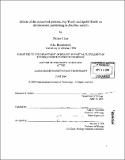Effects of the conserved proteins, Soj (ParA) and SpoOJ (ParB) on chromosome partitioning in Bacillus subtilis
Author(s)
Lee, Philina S. (Philina Sharlene), 1976-
DownloadFull printable version (5.999Mb)
Other Contributors
Massachusetts Institute of Technology. Dept. of Biology.
Advisor
Alan D. Grossman.
Terms of use
Metadata
Show full item recordAbstract
The Par system contributes to stable inheritance of plasmids and chromosomes in diverse bacterial species. Faithful chromosome partitioning is important to dividing cells because anucleate, or chromosomeless, cells are not viable. Since the discovery of the Par system in low-copy number plasmids over 20 years ago, research has focused on characterizing its components: ParA, a DNA-binding ATPase, ParB, a DNA-binding protein that interacts with ParA, and parS, the site bound by ParB. How these proteins function to stabilize parS-containing plasmids or chromosomes remains to be elucidated. Less is known about the chromosomally-encoded Par systems. Intriguingly, in several organisms including Bacillus subtilis, chromosomally-encoded Par systems play important roles in cellular processes besides chromosome partitioning. This thesis focuses on characterizing the roles of Soj (ParA) and SpoOJ (ParB) of B. subtilis in chromosome partitioning. These proteins were first identified by their effects on sporulation. My results indicate that Soj and SpoOJ contribute to timely separation of replicated chromosomal origins, and argue against the model that SpoOJ anchors replicated origins to putative receptors in opposite halves of the cell. Additionally, I show that Soj and SpoOJ regulate replication of initiation, and propose that this regulation may occur by a similar genetic hierarchy through which they regulate initiation of sporulation.
Description
Thesis (Ph. D.)--Massachusetts Institute of Technology, Dept. of Biology, 2004. Includes bibliographical references.
Date issued
2004Department
Massachusetts Institute of Technology. Department of BiologyPublisher
Massachusetts Institute of Technology
Keywords
Biology.